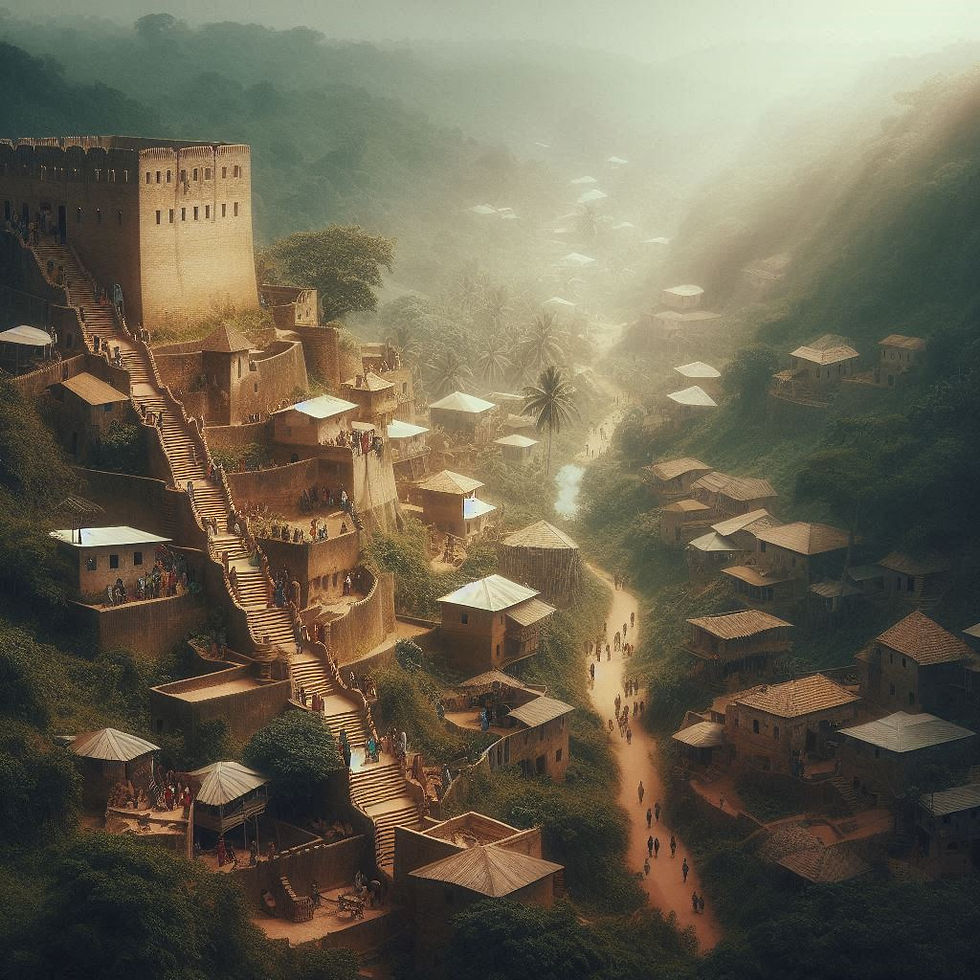Exploring the Historic Castles and Forts of Ghana: A Journey Through Time
- orpmarketing
- May 20
- 7 min read

Introduction
Ghana’s coastline, once known as the Gold Coast, is dotted with castles and forts that stand as enduring testaments to centuries of trade, conquest, and human struggle. These structures, primarily built by European powers between the 15th and 19th centuries, played pivotal roles in the gold and slave trades, shaping not only Ghana’s history but also the global narrative of the African Diaspora. This blog dives into the origins, purposes, current conditions, and tourism potential of these remarkable sites, with a focus on Ghana, while touching on notable forts across Africa. We’ll also explore how Ghana can maximize tourism revenue from these historical treasures, backed by data and insights.
The Castles and Forts of Ghana: A Historical Overview
Ghana boasts the highest concentration of colonial-era forts in Africa, with around 30 surviving structures along its 500-kilometer coastline from Keta to Beyin. These were constructed by European powers—Portuguese, Dutch, British, Danish, Swedish, and others—between 1482 and 1786. Their initial purpose was to facilitate trade in gold, ivory, and timber, but by the 16th century, many became central to the transatlantic slave trade, holding enslaved Africans before their harrowing journey through the “Door of No Return” to the Americas. Some forts later served as administrative centers during British colonial rule in the 19th century.
Key Castles and Forts in Ghana
Elmina Castle (São Jorge da Mina)
Built By and When: Constructed by the Portuguese in 1482, it’s the oldest European building south of the Sahara. The Dutch captured it in 1637, and it later fell to the British in 1872.
Original Use: Initially a trading post for gold and ivory, it became a major hub for the slave trade, with dungeons holding up to 1,000 enslaved people at a time. It also served as an administrative center.
Current State: Extensively renovated, Elmina Castle is a UNESCO World Heritage Site and a well-maintained museum. It offers guided tours that vividly recount its history, including the slave trade’s atrocities.
Tourism Appeal: One of Ghana’s top tourist attractions due to its historical significance, well-preserved state, and emotional resonance, particularly for African Diaspora visitors.
Cape Coast Castle (Carolusborg)
Built By and When: Established by the Portuguese in 1555 as a trading lodge, rebuilt by the Swedish in 1653, and taken by the British in 1664.
Original Use: A center for timber and gold trade, later a key slave trade hub with dungeons for thousands of enslaved Africans. It also served as a British colonial administrative seat.
Current State: A UNESCO World Heritage Site, well-restored with a museum and guided tours. The “Door of No Return” is a focal point for visitors.
Tourism Appeal: Rivals Elmina for popularity due to its historical weight and proximity to Elmina, making it part of a common tourist itinerary.
Fort Christiansborg (Osu Castle)
Built By and When: Built by the Danish in 1661, with later modifications by the Portuguese and British.
Original Use: A trading and administrative center, it also held enslaved people. It served as the seat of government during parts of the 19th and 20th centuries and remains so today.
Current State: Used as Ghana’s presidential residence, it’s closed to the public, limiting its tourism potential.
Tourism Appeal: Minimal due to restricted access, though its historical significance is undeniable.
Fort Amsterdam (Cormantin)
Built By and When: Built by the English in 1631 as a lodge, converted to a fort in 1638, and captured by the Dutch in 1665, who rebuilt it.
Original Use: A trading post for gold and slaves, it was a key Dutch stronghold.
Current State: Partially restored but in poorer condition than Elmina or Cape Coast. It’s open to visitors but less developed for tourism.
Tourism Appeal: Attracts fewer visitors due to its state of disrepair and less prominent historical narrative.
Fort William (Anomabu)
Built By and When: Constructed by the British in the 18th century, with earlier structures dating back to the 1640s.
Original Use: A major slave trade hub, considered one of the strongest forts on the Gold Coast in the 1700s.
Current State: Remains visible but in ruins, with limited restoration. It’s managed by the Ghana Museums and Monuments Board (GMMB).
Tourism Appeal: Draws some visitors due to Anomabu’s historical significance, but its dilapidated state limits its draw.
Fort Prinzenstein (Keta)
Built By and When: Built by the Danish in 1784.
Original Use: Primarily a slave trade fort, it protected Danish interests against rival Europeans.
Current State: Severely damaged by coastal erosion, though a sea defense wall has been built to stabilize it. It’s open to visitors but in poor condition.
Tourism Appeal: Limited due to its remote location and state of disrepair.
Other Notable Forts:
Fort Good Hope (Senya Beraku): Dutch-built in 1667, used for trade and defense, now in partial ruin.
Fort Patience (Apam): Dutch-built in 1697, used for trade, now a minor tourist site.
Fort Metal Cross (Dixcove): British-built in 1692, used for trade and slave holding, partially restored.
Fort Fredericksburg (Amanful): Built by the Brandenburg-Prussians in 1683, now in ruins.
Many of these smaller forts are abandoned or in ruins, with minimal tourism infrastructure.
Castles and Forts Across Africa
While Ghana has the highest concentration of colonial forts, other African countries host significant fortifications:
Senegal: Gorée Island’s House of Slaves (late 18th century, Dutch and French) is a UNESCO site and a major draw for its slave trade history.
Nigeria: Badagry’s forts, like the Point of No Return (19th century, Portuguese), attract heritage tourists but are less developed than Ghana’s.
Mozambique: The Fort of São Sebastião (1558, Portuguese) on Ilha de Moçambique is a UNESCO site, used for trade and defense, now a tourist attraction.
South Africa: The Castle of Good Hope (1666, Dutch) in Cape Town is well-preserved, serving as a museum and military site.
These sites, like Ghana’s, were built for trade and defense, with many tied to the slave trade. However, Ghana’s forts stand out for their density and UNESCO recognition.
Tourism Appeal and Visitor Trends
Top Attractions in Ghana
Elmina and Cape Coast Castles are Ghana’s most visited forts, attracting international tourists, especially from the African Diaspora, due to their well-preserved state, UNESCO status, and emotional connection to the slave trade. In 2019, the “Year of Return” campaign, marking 400 years since the first enslaved Africans arrived in Virginia, boosted tourism, with over 1.1 million international visitors generating $3.3 billion in revenue. These castles host guided tours, museums, and events like PANAFEST, a festival promoting Pan-Africanism, which further drives visitors.
Why They Attract Tourists
Historical Significance: Their role in the slave trade resonates deeply, especially with African American and Caribbean visitors seeking heritage connections.
Accessibility: Located near Accra and Kumasi, with good infrastructure (hotels, roads), they’re easier to visit than remote forts like Prinzenstein.
Restoration and Interpretation: Investments from USAID, the Smithsonian, and the GMMB have enhanced displays and guides, making visits immersive.
Smaller forts like Fort Amsterdam or Fort William draw fewer visitors due to their poor condition, remote locations, or less prominent historical roles.
Africa-Wide Comparison
Ghana’s forts outshine many African counterparts due to their concentration, UNESCO status, and government promotion. Senegal’s Gorée Island competes closely, with similar Diaspora appeal, but Ghana’s multiple sites offer a broader experience. South Africa’s Castle of Good Hope attracts diverse tourists due to its urban location and broader historical narrative, but it lacks the slave trade focus.
Current State and Challenges
Many of Ghana’s forts face preservation challenges:
Erosion: Coastal forts like Prinzenstein are threatened by sea erosion, with parts of the structure lost.
Funding: Limited budgets hinder maintenance, especially for smaller forts.
Accessibility: Forts like Christiansborg are closed to the public, reducing their tourism potential.
Development Pressure: Urban expansion and quarrying near some sites threaten their integrity.
Elmina and Cape Coast, however, benefit from ongoing restoration and international support, making them models for preservation.
Maximizing Tourism Revenue: Opportunities and Strategies
Ghana’s tourism sector, valued at $2.3 billion in 2022, has significant growth potential. Here are strategies to maximize revenue from forts and castles, supported by data-driven insights:
Enhance Preservation and Accessibility
Action: Invest in restoring lesser-known forts like Fort William and Prinzenstein, using models like Elmina’s USAID-funded restoration. Create buffer zones to protect against erosion and development.
Impact: Restored sites attract more visitors. For example, Cape Coast’s restoration in the 1920s and 1990s boosted its status as a top destination.
Cost-Benefit: The 2019 Year of Return showed a 1% increase in tourism revenue can add $23 million annually. Restoration costs (e.g., $1-2 million per fort) could yield high returns.
Develop Niche Tourism Experiences
Action: Offer immersive experiences like reenactments, virtual reality tours of dungeons, or Diaspora-focused genealogy workshops. Promote eco-tourism and cultural festivals (e.g., PANAFEST) at fort sites.
Impact: Niche tourism (e.g., heritage, adventure) is projected to drive Ghana’s post-COVID recovery, with 1 million international visitors expected annually.
Example: Senegal’s Gorée Island uses storytelling and cultural events to enhance visitor engagement, a model Ghana could replicate.
Improve Infrastructure and Marketing
Action: Develop tourist complexes near forts, including hotels, water parks, and cultural centers, as proposed by the Ministry of Tourism, Arts, and Culture (MoTAC). Launch global campaigns like “Destination Ghana” to target Diaspora and European markets.
Impact: The 2019 campaign increased arrivals by 18% year-on-year. Improved infrastructure could sustain this growth, targeting 2 million visitors by 2030.
Data: Ghana’s services exports, including tourism, reached $9 billion in 2020, showing potential for growth with better facilities.
Community Involvement and Sustainable Tourism
Action: Engage local communities in tourism management, as seen in ecotourism projects like crocodile ponds, which employ locals and generate revenue. Train local guides and artisans to




Comments